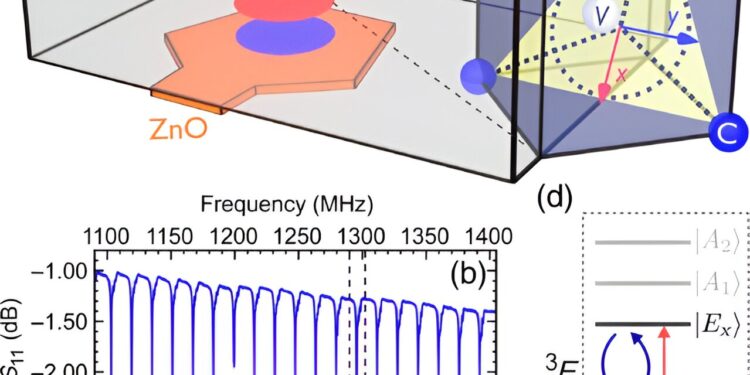A diamond bulk acoustic wave resonator for acoustic orbital control. Credit: PRX Quantum (2024). DOI: 10.1103/PRXQuantum.5.030336
Researchers at Cornell University have demonstrated that acoustic sound waves can be used to control the motion of an electron as it orbits a lattice defect in a diamond, a technique that could potentially improve the sensitivity of quantum sensors and be used in other quantum devices.
Advances in quantum information technology require new ways to control electrons and other microscopic particles. In a paper titled “Coherent Acoustic Control of Defective Orbital States in the Traction Force Limit,” Gregory Fuchs, professor of applied physics and engineering, and his postdoctoral associate Brendan McCullian collaborated with Erich Mueller, professor of physics in the College of Arts and Sciences, and his doctoral student Vaibhav Sharma, to design an environment in which sound waves can cause “quantum jumps” between electron orbits.
The work was published in the journal PRX Quantum.
McCullian built a microscopic speaker on the surface of a diamond chip, which operated at a frequency that exactly matched an electronic transition. Using techniques similar to those employed in magnetic resonance imaging, he was able to demonstrate the coherent control of a single electron inside the diamond chip.
Qubits, the quantum analog of bits in a classical computer, must remain coherent, or in a stable state, to be useful. This coherence is very fragile and is easily lost due to fluctuations in the environment, such as when a nearby electron jumps from one place to another. For many years, scientists have been extending the coherence times of qubits using a technique called spin resonance, which uses microwaves and magnetic fields to alter the behavior of electrons. Fuchs and his group have been trying to extend this technique to acoustics and improve the coherence of orbitals.
“We acoustically steered the orbital states in a way that was somewhat analogous to spin resonance, and then used the established toolbox of spin resonance techniques to study the coherence of that orbital state,” Fuchs said. “It was very exciting for us to be able to do an orbital version of spin resonance: take the tools we know from spin resonance (e.g., coherent control and Rabi oscillations) and, with a few-gigahertz acoustic resonator, apply them to orbital states and see that these techniques are still valid.”
Fuchs’ work contributes to advancing knowledge of the nitrogen vacancy (NV) center, a defect in diamond crystal lattices that is an important qubit for quantum sensing and networking, and helps develop new tools to combat environmental fluctuations that lead to spectral scattering, which can cause major problems in quantum network applications that rely on a stable optical transition where the frequency of each emitted photon is the same.
“By studying how the NV center interacts with these noise sources and finding ways to modify that interaction using tools we normally reserve for spins, we found a way to make it work with orbital states. That’s an important addition to science,” Fuchs said. “This project is also an example of how collaboration between teams should work. The experimental techniques were developed in my lab, but we then collaborated with a group in the physics department who provided theoretical analysis and helped us formulate our predictions and understand the results.”
“It was an extremely rewarding collaboration,” Mueller said. “The acoustic waves excited the electrons using a mechanism similar to that used to ‘pump’ a swing on a playground. When the vibrations are synchronized with the movement of the electrons, they can transfer energy to them. It’s really amazing that you can control the movement of electrons with what is essentially a loudspeaker.”
More information:
BA McCullian et al., Coherent acoustic monitoring of defect orbital states in the strong excitation limit, PRX Quantum (2024). DOI: 10.1103/PRXQuantum.5.030336
Provided by Cornell University
Quote: Sound causes ‘quantum jumps’ between electron orbits (2024, August 26) retrieved August 26, 2024 from
This document is subject to copyright. Apart from any fair dealing for the purpose of private study or research, no part may be reproduced without written permission. The content is provided for informational purposes only.



